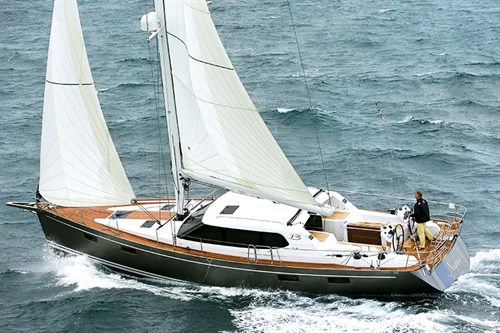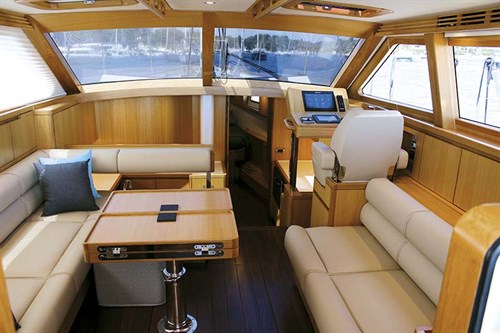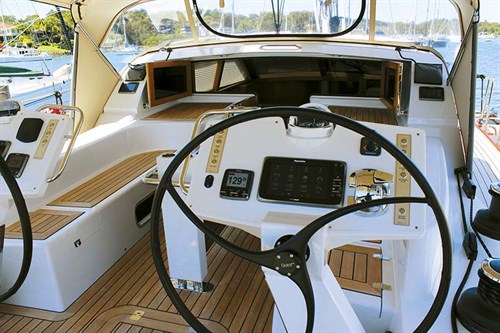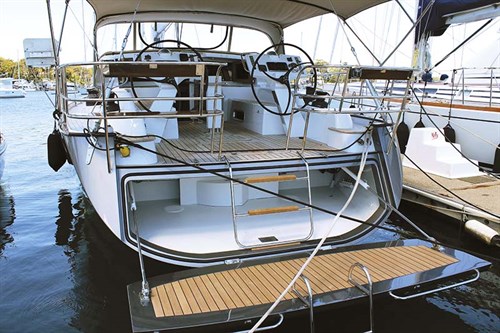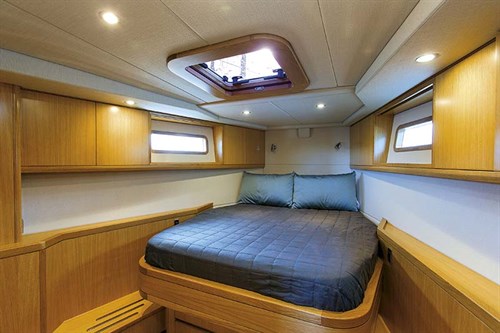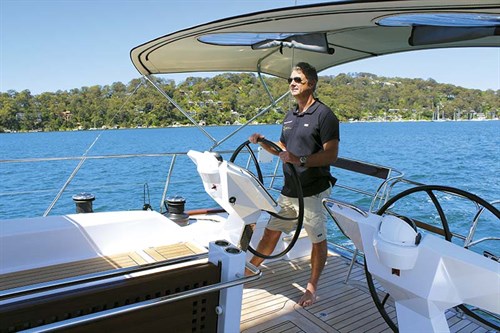The Buizen Yachts sailing boat company has come a long way. Indeed, the latest Buizen 52 (hull #3) is an immaculate example of the art of yacht building.
The antithesis of mass production of sailing boats can be found in a few places around Australia and one of these rare places is Terrey Hills, north of Sydney. Here Steve Howe has successfully revamped the boatbuilding legacy of brothers Eddy and Fritz Buizen since taking over in 2005.
When the brothers ran the yard 10,000 man hours were spent producing its hand-built customised cruisers where everything was discussed, including individual hull colours and materials. Their later models were epitomised by the award-winning Buizen 48 that was a sturdy and seaworthy cruiser.
However, moving forward, new owner Steve Howe realised that this alone wasn’t enough. “We needed to build in performance and a more contemporary look and that is what Peter Lowe has designed for us,” he told us.
BUIZEN 52
The grey-hulled Buizen 52 lying at the Prince Alfred Yacht Club pontoon represents a year’s work for the yard which can build two sailing boats annually. However there’s nothing old fashioned about how it does this, as can be seen from the CNC machining, and the building of the entire interior while the vinlyester hull is resin infused.
“But our tolerances are very fine, so we need the very best from our cabinetmakers and fabricators,” explained Steve as we look over hull #3 that is destined for Perth in Western Australia.
The Buizen 52 continues the Buizen 48’s layout of a forward owner’s stateroom with separate shower, toilet and vanity unit.
In the deck saloon, the raised area has the navigation desk down below and aft, couches midships and the internal helm station high on the starboard quarter. The galley adjoins the owner’s stateroom and spreads across midships to allow for plenty of area for the Corian-topped work surfaces.
Underfoot, walnut flooring throughout feels nice in bare feet and will last a lifetime – with no creaks noted either as I moved around.
At the stern the symmetrical guest cabins share a bathroom and the port one hides the Miele washer/dryer in a cupboard.
SALOON
The dominant feature of Buizen 52 saloon is the light American oak woodwork and cream leather upholstery that sets a modern tone, while the large rectangular windows stream light everywhere. Interestingly while seated, you cannot see out of them unlike, say, the Moody 45 Deck Saloon, but that is a personal preference.
There’s no such problem at the raised internal helm where the large raked windows allow the skipper to clearly command the boat – just click the Raymarine autopilot to alter course or push the throttle controlling the 160hp Yanmar. This area bristles with controls including the excellent CZone digital CAN-bus that manages all the Buizen 52’s systems. Above it, a large Raymarine G Series multifunction display gives charting, radar displays and camera output.
Engine controls, including rev counter and battery status are at thigh level, along with buttons for the 10kVa Fischer Panda generator, so when the weather outside is inclement you only need to step out to push the binnacle buttons for sail trimming.
HELM
Cockpit access in the Buizen 52 is via an unusual but effective main hatch arrangement that has a swing door with window above and on either side that open up the aft part of the saloon. The cockpit is sheltered behind the high deck saloon and tall coamings make this a cosy area at sea.
For entertaining, a cleverly designed table slides up and unfolds on its sturdy stainless steel base, while overhead the canvas bimini covers the entire area (or can be unzipped). Behind sit the twin GRP helms which offer a clear walkway through to the stern where a transom garage for dinghy storage is hydraulically operated to create a swimplatform.
The steerer has full command of the yacht from these binnacles thanks to button-operated control of the electric Harken primary and mainsheet winches; and our review boat came with a self-tacking jib so you can go to windward without touching anything.
DECK
No expense is spared on these binnacles, so on both you have a throttle, joystick for the drop-down bowthruster, Raymarine e7 plotter and buttons for trimming. I particularly liked the shape and feel of the composite Goit steering wheels that have mechanical linkages to the deep spade rudder.
On deck the 9mm teak felt sure underfoot as I walked forward and the three-inch (7.6cm) high bulwark gives confidence in a seaway, amply aided by the handrails on the deck saloon top.
The teak centre walkway in front of the mast is yet another quality touch that makes working at the bow comfortable. A deep bow locker has room for more than just the rode, while a large vertical Lewmar windlass with capstan sits behind a single roller that runs through the bowsprit. The bowsprit is long enough to give good separation should you want to fit a genoa and to fly a cruising chute.
For this Buizen hull a fairly high specification rig was chosen, the NZ Rigging carbon mast held up by Dyform wire shrouds and a hydraulic backstay. An alloy Leisure Furl boom attaches and is strongly supported by a Reckmann hydraulic vang.
Furling booms have their supporters and detractors – unless the sailcloth is specified exactly and the mechanism of quality, I have had experiences of them jamming. But none of this criticism applies to the Buizen 52, as I found when using it at sea. Also, the hydraulic system has a manual over-ride by winch handle. Another advantage with boom furling is putting the weight of the furled mainsail low in the boat.
INTERIOR
The modern hull design creates plenty of volume throughout the Buizen 52 without being overly beamy or having exceedingly high topsides and nowhere is this more apparent than the engineroom.
Accessed from the saloon floor, you drop down into a spacious area with the Yanmar shaftdrive set forward, with fuel tanks either side. There’s access forward from the galley to check the alternator fan belts. Nearby at hand are the fuel filters, while behind sits the Fischer Panda generator with watermaker alongside.
Skin fittings are of course quality bronze and the bilges are deep enough to keep everything dry, while quiet extractor fans control the heat. The area isn’t overly busy as Buizen has wisely chosen to distribute its operating systems throughout the boat (see breakout).
The Buizen hull looks beautifully done – built to ISO and CE standards, with no rough fibreglass edges and of course the infused construction means a consistent level of vinylester throughout. Solid GRP is moulded around the base with Corecell elsewhere and a glassed-in metal grid gives rigidity to the 52-foot hull.
The keel join is enveloped as part of the hull and the cast iron fin has an L-shaped six-ton lead bulb that should allow her modest sail area to be kept flying even in a strong breeze. Also a figure of 19.1 for her sail area to displacement ratio (SAD) puts her in the realm of ocean-racer class, so no worries about seaworthiness for this bluewater cruiser.
SAILING ON PITTWATER
Chasing the moving pressure on Pittwater may be fun for the locals but for us Sydneysiders it can be perplexing, so I was glad of the smooth engine power to put us among the ruffled water. Using the engine was the first indicator that this might be a slippery hull, the turbocharged Yanmar quietly speeding us along to a max speed of 9.4kts as it lazily spun at 2500 revs, with no shudders felt through my hands on the wheel. For a longer trip I would have clicked into reverse to engage the three-bladed Gori propeller’s useful overdrive pitch that saves fuel – but I had other plans. Slowing down to await the breeze I went into reverse to check tracking aft, the Buizen behaving predictably and like any modern production cruiser.
With the northerly breeze filling in nicely it was time to click the main halyard button to hoist the Hood Hydranet mainsail, which was done quickly before the jib was rolled out and set. With jammers and manual winches everything on the Buizen can be controlled by hand, apart from simply pushing the buttons. Which is just as well as this boat can definitely move and I confess to being rather surprised by how nippy this 18-tonner with modest sail area turned out to be.
Boom furling means limited tuning of the sail while set but the Hood Hydranet mainsail set beautifully with enough belly to give good shape. The advantage of Hydranet over standard Dacron is its close weave incorporated with Dyneema which gives low stretch and durability, so a worthwhile upgrade.
Gliding rather than accelerating we quickly reached nearly 7kts in the 12kt breeze, fairly hard on the wind at 45-degrees. It was easy to maintain the speed, the 52 proving a forgiving boat while I fidgeted with camera at the steering wheel. A balanced helm means little effort for the steerer or the autopilot, so the experience had me fully engaged as I leaned out to ensure the jib telltales were horizontal, while being slightly hampered by the Y-shaped backstay.
Tacking without needing to touch any winches left me to focus on boatspeed through the turn and the deep spade rudder drove us quickly round until we’d zig-zagged our way to Avalon Beach. But then I actually had to do something – push the mainsheet button to release the sail after I gybed around on a broad reach to clear water again.
Line tails are neatly stored in lockers near the winches, so there’s nothing to snag your feet as you move. Off the breeze, running at 120-degrees we saw 8.8kts over the ground on the e7 plotter as the wind rose to 14kts. “Lively and responsive,” I scribbled into the notebook while the boat steered herself.
THE VERDICT
I can now fully understand why Buizen hull number #2 managed a third spot in the competitive cruising division of Hamilton Island Race Week this year. Clearly the Buizen 52 is a sailing yacht worth waiting a year for!
Originally published in Trade-A-Boat #247, November / December 2014. Why not subscribe today?
HIGHS
• Outstanding quality throughout
• Surprising performance
• Excellent galley
LOWS
• No seated views from saloon couches
• Teak foot-chocks at helms would be nice
BUIZEN 52 SPECIFICATIONS
PRICE AS TESTED
Buizen 52 price: $A2,360,000 incl. GST
OPTIONS FITTED
Watermaker, lithium batteries, satellite TV/phone, Wi-Fi dome, HF radio, air-con, six-man liferaft, carbon mast, bowsprit, MPS chute and bimini infill
GENERAL
MATERIAL GRP
TYPE Fixed keel sailing yacht
LENGTH 15.85m
BEAM 4.76m
DRAFT 2.2m
WEIGHT 18,465kg (6000kg ballast)
CAPACITIES
PEOPLE (night) 6
FUEL 1280lt
WATER 793lt
ENGINE
MAKE Yanmar
TYPE Shaft-drive turbo-diesel engine
RATED HP 160
PROPELLER Gori (folding)
SAILS
MAINSAIL AREA 74.5m²
JIB AREA 53.6m²
MPS SPINNAKER TBA
SUPPLIED BY
BUIZEN YACHTS
57 Myoora Road,
Terrey Hills, NSW, 2084
PHONE (02) 9450 2170
Photography: Kevin Green & Andrea Francolini









